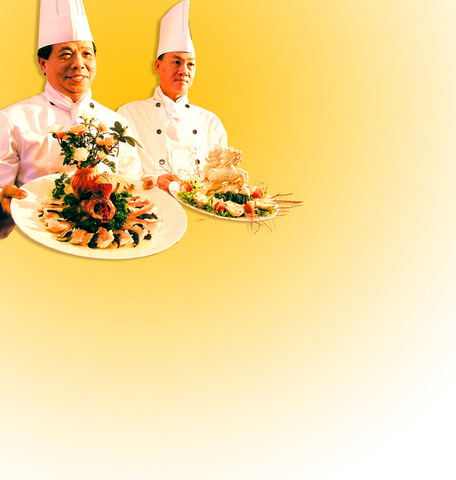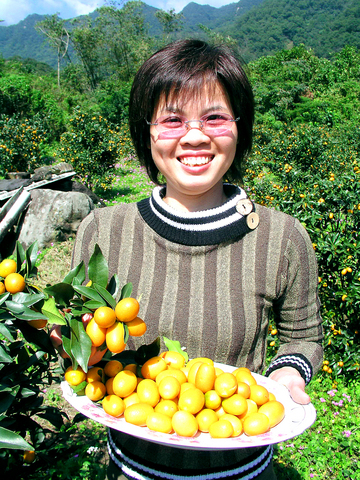The festive atmosphere still burns two days after the Lantern Festival with events and celebrations going on all over the country. But the end of the Lantern Festival marks the end of the whole Chinese New Year season, and a good way to calm down from a whole month of holiday excitement is to escape from the city, take a trip by train to Ilan County and join the Ilan Food and Tourism Festival (
The festival began on Wednesday and will last until Sunday at Minsheng Market (民生市場) of Luo-tung Township. The festival lets tourists enjoy food, the beautiful Ilan scenery and take part in a stir-fried rice contest, all in one trip, according to Ilan County magistrate Liu Shou-cheng (劉守成).

Like last year, Liu and the Ilan Tourism Association (宜蘭縣觀光協會) recruited award-winning chefs to create dishes that are the highlights of the festival. This year, there are 16 chefs who have come from 16 Ilan restaurants and hotels for the festival.

PHOTO: TAIPEI TIMES
Together they will turn Ilan specialties such as candied fruits, sticky-rice cakes, duck jerky (
Ilan County has long been a traditional agricultural society and has been described as "behind the mountains" (

PHOTO: TAIPEI TIMES
Each of the foods has a geographic connection. Duck jerky, for example, was created because of the constant flooding of the Tung-shan River (冬山河). The floods affected the harvests and made farmers raise ducks by the river for extra income. Because it was inconvenient to transport fresh duck meat, farmers began to smoke the duck meat with sugar cane in order to make dry meat to sell elsewhere.
Kao-cha, a deep-fried meat cake, is a dish originally created from left-over food. People used to mix bone soup stock, pork fat and corn starch, then freeze the mix to make meat jelly, and finally deep fry the jelly blocks.
Chef Chen Chao-ling (陳兆麟), the lead chef of the food festival and a celebrity chef who took charge of President Chen Shui-bian's (陳水扁) national banquet in Ilan, presents a high-end version of kao-cha. The bone soup and pork fat is replaced with ground chicken, pork and shrimp that are made into a paste. The paste is mixed with chicken stock and potato starch to thicken it and then the "meat tofu" is cut into blocks. The blocks are deep fried until they turn golden.
Apart from the local specialties, the food fair also presents 100 chicken dishes to mark the Year of the Rooster. The dishes are prepared by the 16 participating restaurants, and among the 100 chicken variations are braised chicken breast, chicken salad, stuffed chicken, roast whole chicken, chicken stir fries and plentiful choices of chicken soup.
Finally, the festival offers a stir-fried-rice contest for all participants where they can show off their cooking skills. Although a simple and common dish, stir-fried rice can be a disaster if the cook is given only 20 minutes, some ham, pork shreds, eggs, beef, shrimp, garlic, scallions and only a few seasonings to work with.
Of course, a food fair is not complete without drinks. Heineken is offering a contest to let participants imitate the Heineken TV commercial by dredging up beer bottles from an ice bucket. Plenty of beer will be given to the winners.
EVENT INFORMATION:
What: Ilan Food and Tourism Festival
When: Feb. 23 to Feb. 27
Where: Ming-sheng Market, 6 Ming-sheng Rd, Luo-tung Township, Ilan County (
For more information, call the Ilan Tourism Association at (03) 988-8333
Participating Restaurants:
Cha Bu Duo Restaurant (
Good Taste Seafood (
Du Hsiaw Uye, Luo-tung branch (
He Feng Hot spring Hotel (
Thai Dynasty Restaurant (
Kinmen Restaurant (
Du Hsiaw Uye, Ilan branch (
Chili Garden (
Jing Dian Restaurant (
Jin Tsun Restaurant (
Sea Capital Restaurant (
Musashi Japanese Restaurant (
Wu Tao Restaurant (
Yo-ai Hotel, Dim Sum House (
Landis Inn, Luo-tung (

June 2 to June 8 Taiwan’s woodcutters believe that if they see even one speck of red in their cooked rice, no matter how small, an accident is going to happen. Peng Chin-tian (彭錦田) swears that this has proven to be true at every stop during his decades-long career in the logging industry. Along with mining, timber harvesting was once considered the most dangerous profession in Taiwan. Not only were mishaps common during all stages of processing, it was difficult to transport the injured to get medical treatment. Many died during the arduous journey. Peng recounts some of his accidents in

“Why does Taiwan identity decline?”a group of researchers lead by University of Nevada political scientist Austin Wang (王宏恩) asked in a recent paper. After all, it is not difficult to explain the rise in Taiwanese identity after the early 1990s. But no model predicted its decline during the 2016-2018 period, they say. After testing various alternative explanations, Wang et al argue that the fall-off in Taiwanese identity during that period is related to voter hedging based on the performance of the Democratic Progressive Party (DPP). Since the DPP is perceived as the guardian of Taiwan identity, when it performs well,

A short walk beneath the dense Amazon canopy, the forest abruptly opens up. Fallen logs are rotting, the trees grow sparser and the temperature rises in places sunlight hits the ground. This is what 24 years of severe drought looks like in the world’s largest rainforest. But this patch of degraded forest, about the size of a soccer field, is a scientific experiment. Launched in 2000 by Brazilian and British scientists, Esecaflor — short for “Forest Drought Study Project” in Portuguese — set out to simulate a future in which the changing climate could deplete the Amazon of rainfall. It is

Artifacts found at archeological sites in France and Spain along the Bay of Biscay shoreline show that humans have been crafting tools from whale bones since more than 20,000 years ago, illustrating anew the resourcefulness of prehistoric people. The tools, primarily hunting implements such as projectile points, were fashioned from the bones of at least five species of large whales, the researchers said. Bones from sperm whales were the most abundant, followed by fin whales, gray whales, right or bowhead whales — two species indistinguishable with the analytical method used in the study — and blue whales. With seafaring capabilities by humans